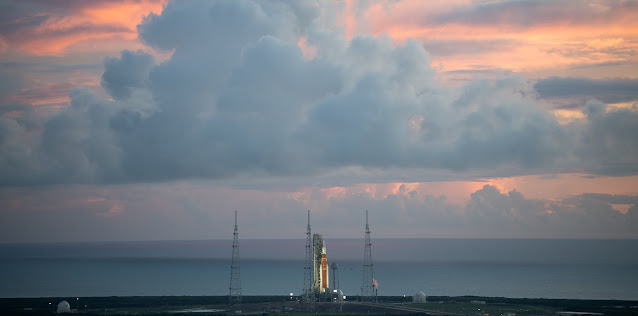Chandamama, Moon
has enamoured mankind from time immemorial.
Scientists have been working hard on reaching to space, moon for scientific discovery, economic benefits, and
inspiration for a new generation of explorers – the rage now is ‘Artemis’.
With the whole World
following its launch, Artemis 1 ran into trouble as team engineers noticed that
one of the engines had an issue with the liquid hydrogen. The launch director
had signed off on a plan to troubleshoot one of the RS-25 engines which was malfunctioning.
But the troubleshooting plan did not work. The countdown clock was put on hold
at T-40 minutes as the hydrogen team discussed options with the launch
director.
Artemis I is
an uncrewed mission that will be the first in a series of increasingly complex
missions to the Moon, eventually taking humans back to Earth’s lone satellite.
During the mission, NASA will demonstrate the performance and capabilities of
its most powerful launch vehicle ever, the Space Launch System (SLS), and the
Orion crew capsule. During the approximately six-week-long mission, SLS and
Orion will travel a distance of around 65,000 kilometres to the Moon and back. With
Artemis missions, NASA will land the first woman and first person of colour on
the Moon, using innovative technologies to explore more of the lunar surface
than ever before. The aim is to have a
long term presence on the moon and then the next giant leap - sending the first astronauts to Mars. NASA’s Artemis 1 launch has now been postponed due to a malfunctioning RS-25
engine on the Space Launch System (SLS) rocket. The US space agency has not confirmed the next
date for the launch, though there are two more launch windows. One is in four
days on September 2, and the second is a few weeks down.
US has landed people on
moon .. .. the Space Shuttle program was
the fourth human spaceflight program carried out by the U.S. National
Aeronautics and Space Administration (NASA), which accomplished routine
transportation for Earth-to-orbit crew and cargo from 1981 to 2011. Its
official name, Space Transportation System (STS), was taken from a 1969 plan
for a system of reusable spacecraft of which it was the only item funded for
development. It flew 135 missions and
carried 355 astronauts from 16 countries, many on multiple trips. The Space
Shuttle—composed of an orbiter launched with two reusable solid rocket boosters
and a disposable external fuel tank; when its mission was complete, the orbiter
would reenter the Earth's atmosphere and land like a glider at either the
Kennedy Space Center or Edwards Air Force Base. The Shuttle is the only winged
crewed spacecraft to have achieved orbit and landing, and the first reusable
crewed space vehicle that made multiple flights into orbit.
STS-51-L was
the 25th mission of the NASA Space Shuttle program, the program to carry out
routine transportation for Earth-to-orbit crew and cargo; as well as the final
flight of Space Shuttle Challenger. Planned as the first Teacher in Space
Project in addition to observing Halley's Comet for six days, the mission never
achieved orbit; a structural failure during its ascent phase 73 seconds after
launch from Kennedy Space Center Launch Complex 39B on January 28, 1986, killed
all seven crew members —Commander Francis R. "Dick" Scobee, Pilot
Michael J. Smith, Mission Specialists Ellison S. Onizuka, Judith A. Resnik and
Ronald E. McNair, and Payload Specialists Gregory B. Jarvis and S. Christa
McAuliffe—and destroyed the orbiter.
Judith Arlene Resnik (1949
- 1986) was an American electrical engineer, software engineer, biomedical
engineer, pilot and NASA astronaut who died in the Space Shuttle Challenger
disaster. Resnik was the fourth woman, the second American woman and the first
Jewish woman of any nationality to fly in space, logging 145 hours in orbit. Recognized
while still a child for her intellectual brilliance, Resnik was accepted at
Carnegie Mellon University, after being one of only sixteen women in the
history of the United States to have attained a perfect score on the SAT exam
at the time. She went on to graduate with a degree in electrical engineering
from Carnegie Mellon before attaining a PhD in electrical engineering from the
University of Maryland.
At age 28,
Resnik was selected by NASA as a mission specialist. She was part of NASA
Astronaut Group 8, the first group to include women. While training on the
astronaut program, she developed software and operating procedures for NASA
missions. Her first space flight was the STS-41-D mission in August and
September 1984, the twelfth Space Shuttle flight, and the maiden voyage of
Discovery, where her duties included operating its robotic arm. Her second
Shuttle mission was STS-51-L in January 1986 aboard Challenger. She died when
it broke up, shortly after liftoff, and crashed into the ocean.
The Space Shuttle
Challenger disaster was a fatal accident on January 28, 1986, in the United
States space program where the Space Shuttle Challenger (OV-099) broke apart 73
seconds into its flight, killing all seven crew members aboard. It was the
first fatal accident involving an American spacecraft in flight. The crew
compartment and many other fragments from the shuttle were recovered from the
ocean floor after a three-month search-and-recovery operation. The disaster resulted in a 32-month hiatus in
the Space Shuttle program. President Ronald Reagan created the Rogers
Commission to investigate the accident. The commission criticized NASA's
organizational culture and decision-making processes that had contributed to
the accident.
With regards – S. Sampathkumar
30th Aug 2022.


No comments:
Post a Comment